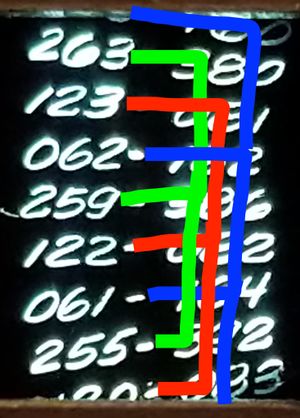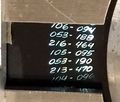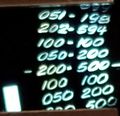X381: Difference between revisions
No edit summary |
|||
| Line 89: | Line 89: | ||
<gallery> | <gallery> | ||
Tek x381 front.jpg | |||
Tek x381 1.jpg | Tek x381 1.jpg | ||
Tek x381 2.jpg | Tek x381 2.jpg | ||
Revision as of 12:16, 9 February 2020
The X381 is an experimental 560-series timebase plug-in. It appears to have used a 3B1 plug-in as a starting point.
No documentation is available for the X381 so everything in this page is just a guess based on examining the one existing plug-in.
Features
- Digital front-panel display of sweep rate in TIME/SEC or Hz.
- Continuous vernier adjustment of sweep rate from the slowest rate to the fastest rate with no discontinuities.
Front Panel
The front panel has:
- a Nixie display which is driven by a Fairchild 9960 decoder/driver IC.
- a two-position slide switch with positions marked "SEC" and "Hz".
- a TIME/DIV knob concentric with a vernier sweep speed knob.
Principle of Operation (a guess)
The rotational position of the vernier sweep speed knob is linked by shafts and gears to the rotational position of the main encoder shaft. Attached to directly to the main encoder shaft are:
- a rotary optical encoder, and
- a free-rotating (no angular stop) precision potentiometer
Each angular position of the main encoder shaft produces a distinct pattern of illuminated or not-illuminated in the 26 optical fibers (or flexible light pipes) that exit the rotary optical encoder. These are optical signals are converted to electrical signals and the electrical signals are fed to the nixie controller ICs. Thus, as the vernier sweep speed knob is rotated, the digital display on the front panel follows it.
Meanwhile, a precision potentiometer is attached to the main encoder shaft. This potentiometer functions in essentially the same way as the vernier sweep speed on a conventional timebase plug-in such as a 3B1. When the rotary optical encoder is at the end of a revolution, an optical signal (one track on the encoder disk) calls for a step of the the 1-2-5 rotary sweep speed switch that is concentric with the vernier sweep speed knob. A motor and gears rotate the rotary switch. The position of the main encoder shaft (and corresponding pattern of fiber illumination) is insufficient to disambiguate which direction to rotate the 1-2-5 sweep speed switch. One possible solution would be to use memory, i.e., to continue in the same direction as recent motion of the vernier knob. The approach taken in the X381 is to use a torque sensor in the vernier knob. A pair of microswitches is attached to the vernier knob. One closes on clockwise torque; the other microswitch closes on counterclockwise torque. The direction of the torque of the vernier knob determines the direction of the step of the 1-2-5 sweep speed switch.
Rotary Optical Encoder
Within the X381, there is an octagonal aluminum enclosure containing a backlit disk of film that is rotated by a front panel knob. The disk functions similarly to a quadrature optical encoder, but instead of generating just two signals, it generates several signals. There are pairs of human-readable numbers on the disk at each rotational position. These numbers are visible outside of the enclosure. Each pair of numbers, when multiplied, gives a product very close to 10,000. Since the two numbers have a reciprocal relationship, one number probably represents the sweep speed in time per division while the other number represents the sweep speed in frequency, e.g., of a waveform that repeats in one horizontal division.
Tektronix X381 optical encoder values are an interleaving of three sequences, each in increments of approximately 1.5% per step
Motorized TIME/DIV
The TIME/DIV control is two concentric knobs.
Outer Knob
The outer knob is the coarse TIME/DIV control, and goes in 1-2-5 steps from 2 sec/div to 1 μs/div. The front panel knob rotates this rotary switch. However, the switch can also be controlled by a motor in the plug-in. When the coarse TIME/DIV control is rotated using the front panel knob, the motor's gear is mechanically disengaged from the rotary switch shaft.
The rotary coarse TIME/DIV switch controls the rightmost nixie tube, which shows the TIME/DIV units.
Inner Knob
The inner knob is probably a vernier TIME/DIV control. The inner knob rotates the optical disk and a precision rotary potentiometer, Tektronix part number 311-0537-01. Each radial position of the disk produces a pattern of light/dark in the light pipes coming out of the disk. The patterns encode vernier TIME/DIV values. Each light pipe goes to a photosensor, which controls the left three decimal nixie tube. The inner knob, like the outer knob, can be rotated by turning the front-panel knob, but is also motor-controlled, presumably to enable automated measurement.
-
-
-
-
-
-
-
backlit with flashlight for photo
-
backlit with flashlight for photo
-




























